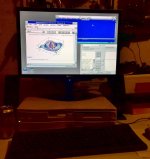Probably been asked a million times, so sorry if it's in a FAQ somewhere...
Anyhoo, I've got a 486dx2/66 system sitting here which has a FM-capable floppy controller, so I'd like to use it with Imagedisk for reading/writing 5.25" floppies for my various old machines. Sneakernetting data between it and my fileserver via 3.5" disk is going to get old fast though, so it would be nice to have it hooked up via Ethernet and running either an FTP client or server.
Does anyone have any recommendation for (free) software to run, for both the TCP/IP stack and the FTP program? The machine's currently running DOS 5.00 and has a 3Com Etherlink III 16-bit ISA card installed, but I think I have a small handful of other ISA NICs to play with if there are any known issues with the Etherlink III boards.
thanks!
Jules
Anyhoo, I've got a 486dx2/66 system sitting here which has a FM-capable floppy controller, so I'd like to use it with Imagedisk for reading/writing 5.25" floppies for my various old machines. Sneakernetting data between it and my fileserver via 3.5" disk is going to get old fast though, so it would be nice to have it hooked up via Ethernet and running either an FTP client or server.
Does anyone have any recommendation for (free) software to run, for both the TCP/IP stack and the FTP program? The machine's currently running DOS 5.00 and has a 3Com Etherlink III 16-bit ISA card installed, but I think I have a small handful of other ISA NICs to play with if there are any known issues with the Etherlink III boards.
thanks!
Jules

